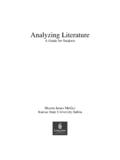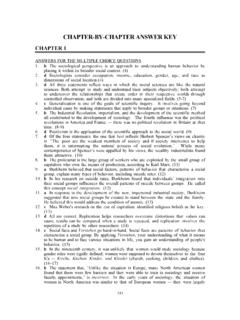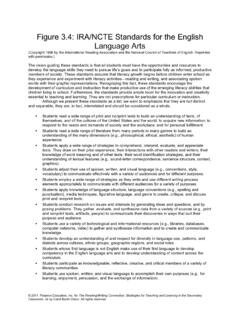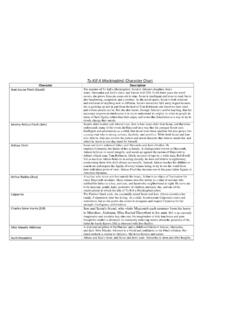Transcription of Selected Guided Practice Activities for Teaching To Kill a ...
1 87 Selected Guided Practice Activities for Teaching To kill a MockingbirdAlthough I like to think that my students have been exposed to a wealth ofpedagogical strategies during their participation in my Methods for Teaching English inthe Secondary School class, they still ask questions about how one weaves thesestrategies together to help students interact with and make meaning from a longer workof fiction. Provided below are a sequence of Selected Guided Practice Activities onemight implement before, during, and after the reading of Harper Lee s To kill aMockingbird. They are culled from the suggestions of a number of Writing Projectteachers--in particular Carol Mooney at Villa Park High School in Villa Park, California,Jerry Judd at Irvine High School in Irvine, California, and Jeff Elsten at Los AmigosHigh School in Garden Grove, California.
2 They are presented in bullets as a skeletonplan for a literature unit rather than as a full-fledged demonstration lesson and theyculminate with various options for writing without taking any specific writing taskthrough the process to completion. (Note: Page numbers referred to are from the 35thAnniversary edition, 1995, Harper Collins.)Prereading Before starting to read To kill a mockingbird , ask students to read The Sneetches byDr. Suess or, better yet, show the video. The Sneetches is the tale of how the Star-Belly Sneetches discriminate against the Plain-Belly Sneetches, excluding them fromgames and weenie roasts, and how Sylvester McMonkey McBean bilks the town outof all of its money by putting on and/or removing stars on the persons of Sneetchesto the point that no one can any longer tell who s who.
3 Ask students to do aquickwrite in reaction to the story. They may be reminded of the holocaust, writeabout prejudice in general, or focus on who the Star-Bellies are at their school. Havestudents share in small groups and then discuss the themes of the story as a wholeclass. Create a context for the novel by reviewing the time frame in which the novel waswritten (in the 1950s during the Civil Rights Movement) and the time frame itfocuses on (the Great Depression of the 1930s). Scott Foresman (Lange, 1997) has anexcellent Novel Works Kit on mockingbird complete with biographical informationon the author, memorabilia from the 1930s (including sheet music for songs,photographs, a letter to Eleanor Roosevelt, an anti-lynching poster, newspaperarticles on the Scottsboro case, etc.)
4 , color art transparencies, a time line, etc. Givesmall groups several documents each and have them teach the class what they havelearned. After groups report, ask students to turn to a partner and relate what hadjust been shared to their reading of The Sneetches. During ReadingChapters 1-8 Read the first three paragraphs of Chapter 1 aloud. Ask students: What kind of a narrator does this novel have? How do you know? Do you agree that this story will be a flashback? Why or why not?88 You have already been introduced to five characters. Who are they and what istheir relationship to one another? What events will the novel trace? How does the writer arouse your curiosity and build suspense?
5 Have students stand and follow the description in paragraph one to imitate Jem sinjury. This may increase their investment in finding out what happens. As students are reading Chapters 1-8, ask them to create character charts for Scout,Jem, Dill, Boo, Calpurnia, Atticus, and Walter. The character chart should include: character s name A quote describing the character s appearance A quote spoken by or about the character that shows personality A one sentence description showing the reader s thoughts/ideas/reflections/speculations about the character After students read Chapter 1-8, have them reread the description of Maycomb onpages 5-6 and find other details about Maycomb from the subsequent , ask them to draw a picture of Maycomb, using details from the text in theirsketches.
6 (Students can turn this sketch into a map when they read Chapters 9-10). Pose this journal activity:Imagine you are Boo Radley at the end of Chapter 8. In his voice, write a diary entryof what is happening from Boo s point of view. Include mention of specificencounters between you (Boo) and the children. You will need to draw inferencesabout Boo s in mind the background information we have on 9-16 Ask students to make a Time Line of the events in these chapters. Give students these study questions to respond to: Scout is involved in three altercations in these chapters. Two are physical, one isnot. Describe each and explain their relationship to the larger context of thenovel.
7 Why do the people of Maycomb resent Atticus for defending Tom Robinson? How do Scout and Jem perceive their father? What causes Jem and Scout to see their father in a new light? Interpret thesignificance of what happens. Why is it a sin to kill a mockingbird ? (Have students start keeping a record ofevery time they come across a reference to a mockingbird in the novel.) Give students the following paragraph quiz. Design a format for the followingquestion as in the model on page 223 of this Chapter 11 of mockingbird , after Jim has learned that Miss Dubose hasdied, he becomes hysterical after opening a box that she has sentcontaining a white, waxy, perfect camellia.
8 Consider the camellia and89 Jem s response to it. What are some possible meanings of the camellia?Comment on their significance. Add two more study questions: How does Mrs. Dubose represent courage in this novel? Explain why the mob disperses at the end of Chapter 17-22 Ask students to pick a judge, prosecutor, defense attorney, defendants, jury, andcourtroom observers. Design a Reader s Theater and have the class re-enact thetrial. Show the clip of the trial from the film version of To kill a mockingbird , starringGregory Peck, up to the point where Reverend Syke s says, Miss Jean Louise, standup. Your father s passin.
9 Give students an Open Mind form. (A blank Open Mind is included on theCompanion Website). In the persona they assumed during the re-enactment of thetrial, students should fill out the Open Mind, drawing pictures, images, and symbolsto represent their thoughts and feelings. They can also use single words and phrasesto capture what was going on in their character s mind at the time. On the back ofthe Open Mind, ask students to explain the meaning of their graphic representation. Assign student groups to create a Talk Show about the trial, the verdict, and thereaction in Maycomb County. A script for getting the show started and guidelinesfor the students who role play the characters written by UCI Teaching CredentialCandidate, Diana Schlecht, is included on the Companion 23-31 Have students keep a Dialectical Journal of the final chapters of the book (seeChapter 5).
10 Have students select quotes that they feel have a special meaning,interest or impact and record them in the left hand column of their journal. On theright side, they should record their thought, feelings, responses, or reflections. Askstudents to label their responses in terms of the cognitive strategies they are using(tapping prior knowledge, predicting, making connections, visualizing, revisingmeaning, and so forth). They can use the Reader Response Starters in Chapter them to be sure to discuss Sheriff Tate s remark on p. 318 in regards to arrestingBoo, Well, it'd be sort of like shootin a mockingbird , wouldn t it? Have students create a Split Open Mind (see Chapter 4) for the character of Scout forthe portion of the novel before and after she is attacked by Mr.












